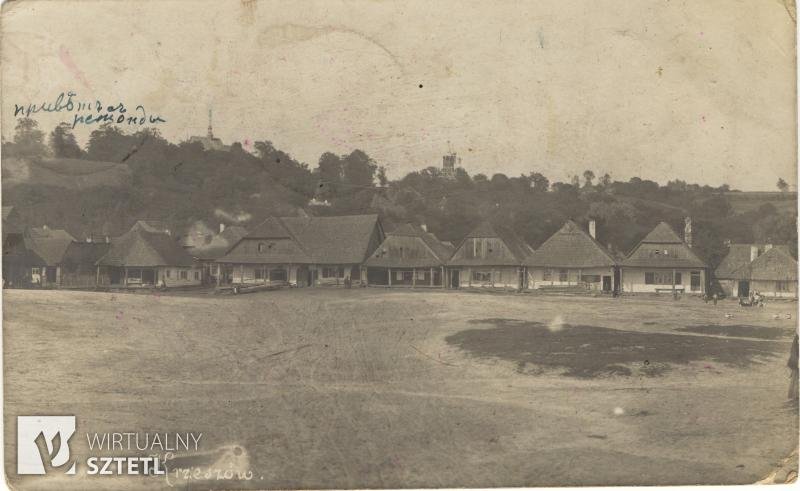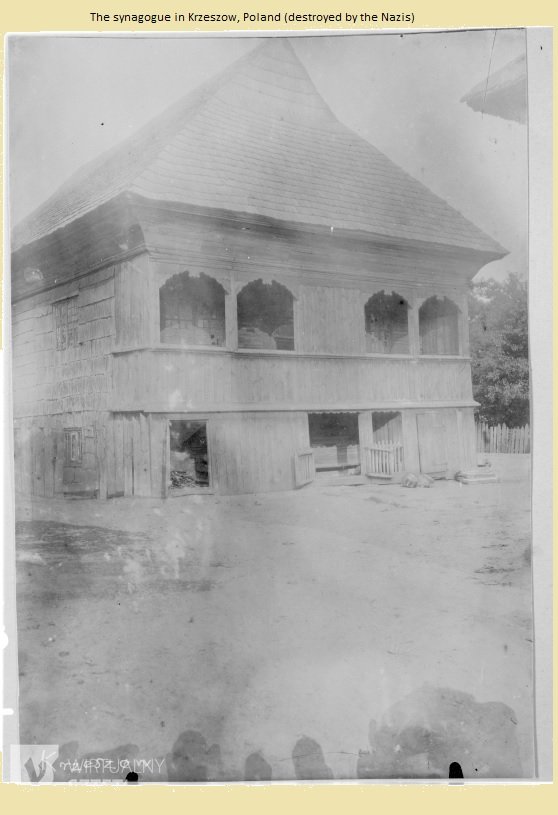Remember Jewish Krzeszów
Pronunciation: Kresh-ov
HISTORY OF JEWISH KRZESZOW
Krzeszow is a village in Nisko County in southeastern Poland. It is on the San River, 21 km. southeast of Nisko and 48 km. northeast of Rzeszow.
Jews began to settle in Krzeszow by the 16th century, however all of the town's original Jews were killed by Khmelnytsky's Cossacks during the Khmelnytsky Uprising. The community revived in the 18th century, and in 1726, the bishop of Przemysl gave the community permission to build a new synagogue.
In 1785 there were 360 Jews in Krzeszow, and in 1860 there were 623 Jews out of 1,012 total residents. The Jewish population peaked in 1867, when Krzeszow was inhabited by 650 Jews out of the total population of 1,093 inhabitants. After World War I, the Jewish population shrank dramatically. In 1921 Krzeszow was inhabited by only 281 Jews. About 1692, Szlojme from Krzeszow was unjustly accused of sacrilege; he refused to convert to Christianity and was hanged. Szmul ben Dawid from
Lublin wrote a song about his martyr death. Isaac Baschevis Singer, a Nobel Prize winner, titled one
of his stories "The downfall of Krzeszow" ("Upadek Krzeszowa"). He must have visited the town many
times, as he perfectly described its pre-war local color and the atmosphere of the Jewish shtetl.
In 1929, the employees of the Jewish community were Chaim Mendel Rojtman, rabbi; B. Manes, secretary of the Jewish community; and Mordka Aszenberg, a shochet. An undated list of Jewish residents of Krzeszow is online at https://sztetl.org.pl/en/towns/k/121-krzeszow/107-lists-of-names/. A listing from the 1929 Jewish employee directory in Krzeszow is as follows:
Alcohol: Mielnik, Sz.
Baker: Flisswaser, R.; Kieslowicz, A.; Mleczko, F.
Doctor: Horowitz, Z.
Fabrics: Bermanzon, L.; Bokser, B.; Berensztajn, Ch.; Brajt, Sz.; Goldrojt, N.;
Maler, Ch.; Maler, J; Maler, Sz.; Nussenfeld, G.
Forest workers: Danziger; Holdhandel, S.A.
Grains: Flug, F.
Grocery: Becher, Z; Blumental, Ch.; Blumental, R; Bokser, J; Boksor, M; Fridland, A;
Furer, M.; Goch, S.; Hajnman, I.; Herszman, M,; Kieslowicz, Sz.; Orensztajn, H.;
Szyffer, Sz.; Tabak, L.; Wajstuch, L.
Haberdashers: Nussenfeld, H.
Land owners: Goldsztajner, Froim (Podolszynka Plebanska 117); Luniewski, Tad.;
Sabo, Jan; Stoboy, Tadeusz.
Leather: Bochner, Sz.; Frydland, I.; Klejnerman, S.; Zychler, R.
Mill: Hochman, Sz.
Oil: Manes, S.
Tin: Perlmuter, E.
Various goods: Langbaum, L.
KRZESZOW DURING THE HOLOCAUST
Following the outbreak of World War II, Krzeszow found itself caught on the border of the Soviet and German occupation zones. Some Jews managed to flee east, however, a new wave of refugees came to the town which consequently led to the increase of the community's size to 600 people. Under the German occupation, there were cases of killings committed by Germans and collaborators, for example in the Chojniak forest. The ghetto was established on January 1, 1940. On Nov. 2, 1942, Jews were sent to Bilgoraj -- from which they were sent to Belzec death camp. The ghetto was liquidated on November 2, 1942.
Krzeszow resident Mieczyslawa Mitkowska recalls, "We lived then together like neighbors. They respected our customs and we respected theirs. Children made jokes but it was not due to racial hatred. We looked with curiosity when people went for a walk with their families after Sabbath dinner. They always walked the same route from the market square across the wooden bridge over San, and then they walked back. The tragedy came along with the German occupation. Never will I forget the events of that day [probably 2
November 1942] -- a two-year old girl shot by a gestapo officer next to the local government building and blood of a child, which splashed on his uniform. An old Jewish woman in a scarf who was killed with a rifle butt by a young Ukrainian. A young girl, a manicurist, who was shot by a handsome S.S. man in a garden located a few yards away, and others who were helpless under rifles and dogs."
The Jewish cemetery in Krzeszow still exists and has 300 tombstones, with one dating back to 1852. Also, in the Chojnak forest, there is an obelisk on the mass grave of the murdered Jews from the towns of Krzeszow, Lipiny, and the nearby towns and villages. This memorial was erected in 1986.
In the 17th century, a wooden synagogue was built in Krzeszow, which was burnt during the great fire of the city in the 17th century. Another one was erected in the 18th century and was burned during the war. In the interwar period, a ritual slaughterhouse operated in Krzeszow. Prices for ritual slaughter at the beginning of the 1930s were as follows: cattle, 8 zlotys; calfs, 3 zl., goose, 80 grams, duck, 50 grams, turkey, 1.5 zlotys, and hen, 40 grams. There was also Jewish ritual bathhouse in Krzeszow, located at ul. Sieniawska 3. According to the budget for 1929, the year-round maintenance of it costed PLN 300.
Please review the site content below. Zachor - We Remember.
------------------------------------------------------------------------
[List of Jewish Residents of Krzeszow (incomplete)]
------------------------------------------------------------------------
Facebook group for Krzeszow Jewish research
Rabbis of Krzeszow:
- Majer Folk
- Chaim Mendel Rojtman
Remember Your Family:
Central Judaica Database - Museum of History of Polish Jews
Grandchildren of Holocaust Survivors on Facebook
Guide to the YIVO Archives
Holocaust News/Events from Generations of the Shoah Int'l
Holocaust Survivors and Victims Database
JewishGen Family Finder
JewishGen Holocaust Database
JRI-Poland: Search for Your Family
Museum of History of Polish Jews Introduction
Yad Vashem: Search for Your Family
Yad Vashem: Submit Names of Your Family Members
Yad Vashem Requests Photos of Shoah Survivors and Families
CONTACTS
U.S.: LublinJewish@gmail.com
Return to Lublin Index


